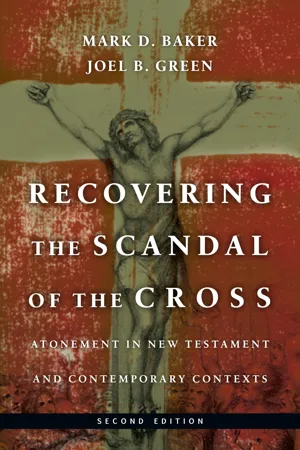![]()
1
Making Sense of the Cross of Christ
“I believe in . . . Jesus Christ his only Son our Lord; who . . . suffered under Pontius Pilate, was crucified, dead, and buried.” This phrase, borrowed from the Apostles’ Creed, is significant for our discussion in at least three ways. First, as A. E. Harvey has rightly observed, incorporating this statement into its rule of faith, the early church gave testimony to its conviction that the crucifixion of Jesus Christ under Pontius Pilate was an incontestable historical event. This is because it ties Jesus’ execution to the historical rule of Pilate, governor of Judea from a.d. 26-36/37, whose records were an open book for any who might want to verify. Indeed, the Roman historian Tacitus assumes the historicity of this event; writing early in the second century a.d. of the persecution of Christians in Rome under Nero, he observed that “Christians” take their name from “Christ, who, during the reign of Tiberius, had been executed by the procurator Pontius Pilate.” The Jewish historian Josephus similarly noted that Pilate condemned Jesus to the cross because of an accusation made by the Jewish leaders in Jerusalem. No other part of the creed is thus tied to the particulars of first-century life in this way.
Second, including testimony to Jesus’ passion in its rule of faith, early Christians underscored what is indisputable in the pages of the New Testament—namely, that Jesus’ execution at the hands of Roman justice, represented theologically in the phrase “Christ crucified,” is central to comprehending the eternal purpose of God as this is known in Israel’s Scriptures. As Ernst Käsemann remarked some forty years ago, for Paul the cross is “the signature” of the resurrected Christ. Although Paul is often acknowledged as having this profound “theology of the cross,” a close reading of the New Testament makes it hard to escape the conclusion that the cross of Christ was common theological ground for all. The plot line of God’s purpose passes through and cannot bypass the execution of Jesus on a Roman cross. Emphatically put: no cross, no Christianity.
Third, given the importance of the crucifixion of Jesus to our faith, it cannot escape our notice that, on the question of how Jesus’ death is significant, and particularly on the question of how Jesus’ death is instrumental for salvation, the Apostles’ Creed is silent. The Nicene Creed is more forthcoming in its witness: “For our sake he was crucified under Pontius Pilate,” but only slightly. The phrase “for our sake” names us as the beneficiary of Jesus’ death but does not articulate how this is so. We find here no sure witness to any particular theory of the saving significance of Jesus’ death.
In fact, as pivotal to our understanding of the life of Jesus as his execution on a Roman cross is, it remains the case that this event, the crucifixion of Jesus of Nazareth, does not contain within itself its own interpretation. Thousands were crucified in antiquity, from about the sixth century b.c. into the fourth century a.d. The practice was associated with various overlords, from the Persians to the Romans. Large numbers of Jews were crucified under the Jewish king and high priest Alexander Janneus (107–76 b.c.), remembered for his crucifixion of eight hundred Pharisees. Even more Jews were crucified by Rome during periods of significant unrest leading up to the Jewish revolt and the fall of Jerusalem in a.d. 70. Additionally, from time to time, agents of Roman rule in Judea condemned individuals to death by crucifixion. Jesus was just one among what must have seemed the countless people to have suffered death in this way. What was peculiar about his demise that it should become the focus of faithful confession and interpretive energy? In fact, the crucifixion of Jesus could be understood in a variety of ways, depending on how the story is told. In other words, by locating the cross of Christ in different narratives, we shift our understanding of the event itself. We can illustrate with reference to the Romans.
Crucifixion in Roman Perspective
The idea that the significance of an event can shift with the narrative in which it is found is easy enough to illustrate. For the Gospel of Luke, for example, Jesus’ ministry of healing and exorcism signifies the coming of the age of salvation, the presence of the kingdom of God, and is a consequence of Jesus’ having been anointed by the “Spirit of the Lord” (see, e.g., Lk 4:18-19). For others, though, Jesus is in league with Beelzebul, the prince of demons, and his exorcisms prove it (Lk 11:15). Later, rabbinic traditions would account for Jesus’ healing as the work of a magician, a manipulator of the spirits who deceived and led Israel astray (b. Sanh. 107b; cf. b. Šabb. 104b); indeed, speaking of Jesus’ execution as a false prophet, the Babylonian talmudic tractate Sanhedrin 43a observed: “He is going forth to be stoned because he has practiced sorcery and enticed and led Israel astray.” All of these sources agree with the datum that Jesus performed exorcisms and healed, but by locating this datum in different story lines, they articulate the significance of Jesus’ ministry in shockingly different ways. The same can be said of the crucifixion of Jesus.
What significance might the Romans have allotted to Jesus’ crucifixion? In fact, it is doubtful that it would have been remembered at all. In Writing History, Paul Veyne develops the importance of “plot” in the narrative representation of historical events, particularly its role in shaping our understanding of those events. By way of illustration, he introduces the death of Jesus, “a mere anecdote in the reign of Tiberius . . . soon to be transformed into a gigantic event”:
A historian who died at the end of the reign of Tiberius most probably would not have mentioned the passion of Christ; the only plot in which he could have placed it was the political and religious agitation of the Jewish people in which Christ would have played, as he wrote of it, and as He still plays for us, the part of a mere figure in the crowd—it is in the history of Christianity that Christ has the main part. The significance of His passion has not changed with time; it is we who change plots when we pass from Jewish to Christian history. Everything is historic, but there are only partial histories.
Of course, Veyne might better have written of the movement from Roman (rather than Jewish) to Christian history, since the point is that the crucifixion of Jesus would have been only one among myriads of such executions for the Romans. As such, it would hardly have deserved a footnote in a history written by a Roman contemporary of, say, Peter or Paul. If it were remembered at all from the perspective of Rome, Jesus’ death might have been used as an illustration of what happens when the mighty arm of the empire responds to one regarded as a threat to Pax Romana. Even the notations from the two historians already mentioned—Tacitus and Josephus—do not contradict but actually underscore this point, since in both cases Jesus’ crucifixion is a topic of interest because of the persistence of those who followed Jesus, not because his execution possessed for them any intrinsic interest.
On the other hand, Rome did have its way of interpreting crucifixion—not Jesus’ death in particular but crucifixion as an instrument of execution more generally. A sample of crude graffiti, a cartoon really, that probably dates from the early second century, portrays a young man worshiping a donkey-headed human figure on a cross. The Greek caption mocks, “Alexamenos worships [his] god”; this unflattering portrait may well be the oldest depiction of “Christ crucified.” Lucian of Samosata (born ca. a.d. 120) wrote a sneering account of a person who had converted to and then rejected Christian faith. Therein, he speaks of “the man who was crucified in Palestine because he introduced this new cult into the world,” and describes Christians as “worshiping the crucified sophist.” This comports well with Paul’s earlier declaration that, from a Gentile perspective, the crucifixion of Christ was sheer folly (mo4ria, 1 Cor 1:18, 23). Indeed, the foolishness of
the cross was seized upon by those antagonistic toward Christians and the Christian message so as to discredit their claims regarding Jesus. As the second-century Christian apologist Justin Martyr remarks, “They say that our madness consists in the fact that we put a crucified man in second place after the unchangeable and eternal God, the creator of the world” (1 Apol. 13.4).
The humiliation and foolishness associated with the cross becomes more clear when we consider the nature of crucifixion among the Romans. On this, the evidence is far more ambiguous than is generally realized and popularly portrayed. Literary sensibilities in Roman antiquity did not promote graphic descriptions of the act of crucifixion. As Cicero remarked in his defense of a Roman senator, “But the executioner, the veiling of the head and the very word ‘cross’ should be far removed not only from the person of a Roman citizen but from his thoughts, his eyes and his ears. For it is not only the actual occurrence of these things or the endurance of them, but liability to them, the expectation, indeed the very mention of them, that is unworthy of a Roman citizen and a free man.” Death on a cross was associated with such shame that it was not a topic for polite company. Even the Gospels are singularly reserved at this point. Reporting simply, “They crucified him” (Mk 15:24; Lk 23:33; Jn 19:18), they lack the sort of detail that apparently belonged to the shared cultural encyclopedia of the Evangelists and their early readers.
Roman practices were guided by their interest in the deterrent value of crucifixion. Quintilian (ca. a.d. 35-100) observed that, “whenever we crucify the guilty, the most crowded roads are chosen, where most people can see and be moved by this fear. For penalties relate not so much to retribution as to their exemplary effect.” Indeed, variation in the manner of how victims were affixed to the cross would have served not only to sadistically entertain but also to leave the victim alive as long as possible for maximum deterrent effect.
Rome did not embrace crucifixion as its method of choice for execution on account of the overwhelming physical pain it caused. This lack of interest in torturous pain is emphasized by contrasting accounts of crucifixion with the portrait of heinous suffering memorialized in the martyr tale of 2 Maccabees 6:18–7:42, in which seven brothers and their mother serially experience scalping, dismemberment, and their bodies thrown into heated pans for frying. Here the descriptive language of bodily punishment and extreme torture is fitting. The act of crucifixion, however, resulted in comparatively little blood loss, and death came slowly, as the body succumbed to shock. This form of capital punishment was savage and heinous, but for reasons other than the physical pain involved. In the honor-and-shame-based culture of Greco-Roman antiquity, bodily torture was not the worst sort of injury. Seneca speaks to...



